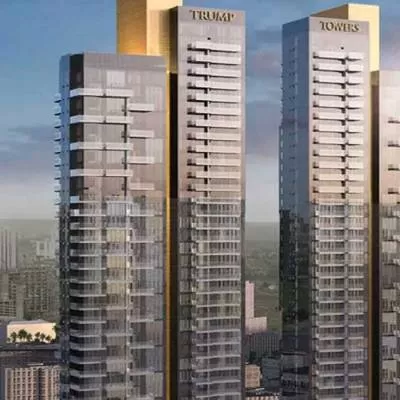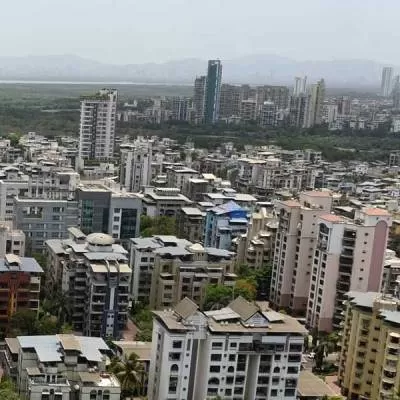- Home
- Real Estate
- A Vision of Tomorrow
A Vision of Tomorrow
According to the UN Global Health Observatory´s findings, cities across the world will witness a high population growth in forthcoming years.
By 2050, almost 70 per cent of the global population will live in cities. A case in point is the megacity of Mumbai, where the population has crossed 1.8 crore, according to the 2011 census, as against 1.2 crore in 2001. If we assume a similar population growth rate and migratory pattern, the city will house more than 4 crore people by 2050.
Given this explosion, the need of the hour is to gear ourselves up to develop structures that will support the demands of a growing population, and withstand the test of time. After all, sustainable housing and infrastructure are the key requisites for a developing economy.
When I say infrastructure, it encompasses residential and commercial facilities, as well as assets such as metros and rails, highways, bridges, tunnels, ports and harbours, cold storage capacities, etc. Development on these fronts will also have a direct impact on other industries such as agriculture, by providing storage facilities to feed the growing population; manufacturing, by enabling growth industries such as automobiles, FMCG, nutrition and pharmaceuticals.
Unfortunately, historically, many infrastructural projects in India were not built for the population explosion or differing climatic conditions we are witnessing today. Extreme weather conditions like rain and heat lead to uneven and pothole-ridden roads, development of cracks in buildings resulting in waterproofing problems, water-logging due to inadequate drainage facilities, etc. These issues need to be addressed now, before it´s too late.
The right chemistry
Without making our current structures strong and durable, it is difficult for us to think of the future. Hence here, chemistry will play an important role. Solutions such as waterproofing systems, insulation systems, precision grouts, adhesives and injections, admixtures for concrete and cement additives, wall systems, flooring systems, mortars, coatings, pigments and dispersions etc, become pivotal. That´s not all - resource efficiency will also play a key role. Hence, the focus needs to be on rapid and cost-efficient construction, easy maintenance, high performance and quality materials, and infrared-reflective coatings, which can all be enabled by innovative chemistry.
Chemistry largely depends on Research & Development (R&D), as it empowers companies with in-depth knowledge of local market needs for specific construction challenges. It will help increase productivity, quicken progress, lower overall costs, reduce consumption of natural resources, improve energy - efficiency and safety processes.
Furthermore, infrastructure is completely dependent on government initiation and support. For a long-term vision, it is important for the authorities to give priority to value-based solutions over a pricing-based tactical approach. Additionally, the government needs to constantly review our existing building and product codes to suit the evolving climatic conditions and population requirements, while ensuring sustainability. In line with this, stakeholders need to study and adopt best practices from emerging global economies and try to replicate them in the country, further boosting customised and tailor-made solutions for the country. Hence, in line with this, stakeholders need to come together and ideate and discuss solutions resulting in right specifications for the right applications. This will help everyone to support the emerging mega-trends in the industry - productivity, economy, durability, and sustainability.
Through these actions, the resulting solutions will definitely support the ever-dynamic market demands. For example: With the introduction of initiatives such as Make in India, Smart Cities and cities under the Atal Mission for Rejuvenation and Urban Transformation (AMRUT), the infrastructure industry has received a much required boost. The Smart Cities and AMRUT cities plan is to develop 500 cities, under the public-private partnership strategy. To put it into perspective, through Smart Cities alone, India will add 11.5 million homes every year.
These initiatives bode well for the construction chemicals industry. To give an estimate, according to a knowledge paper on construction chemicals by Tata Strategic Management and FICCI, Smart Cities are expected to trigger a manifold increase in demand for construction chemicals, with the industry reaching Rs 7,000 crore by 2018-19, from Rs 3,500 crore in 2013-14. Thereby, the industry is expected to grow b 15 per cent per annum over the next five years.
This is exciting as well as challenging. Companies in the infrastructure business need to be ready to support this kind of volume as well as ensure a perfect blend quality, by providing durable and sustainable solutions.
I would like to end this article by paraphrasing Philip Hammond, Chancellor of the Exchequer, Great Britain, ´To those who say our country cannot afford to invest in infrastructure, I say we cannot afford not to invest in our future.´ I absolutely second his opinion as it is the only path towards a sustainable future, and we continue our partnering role towards the advancement of the country.
About the author:
Nilotpol Kar, Business Director, South Asia, for the Construction Chemicals division of BASF India. A Civil Engineering Graduate, with over 28 years of experience in the fields of cement, concrete and construction chemicals, he has worked across Asia, Pacific and Middle East, has been involved in prime projects, and has been associated with promotion of construction chemicals in various types of projects.
- NILOTPOL KAR
- UN Global Health Observatory
- Sustainable housing
- Infrastructure
- Metros
- Rails
- Highways
- Bridges
- Tunnels
- Ports
- Harbours
- Cold storage capacities
- FMCG
- Nutrition
- Pharmaceuticals
- Waterproofing problems
- Water-logging
- Concrete
- Cement additives
- Wall systems
- Flooring systems
- Mortars
- coatings
- Pigments
- Dispersions
- Research
- Development
- AMRUT
- Smart Cities
- Construction
For a long-term infrastructure vision, it is important for the authorities to give priority to value-based solutions over a pricing-based tactical approach, says NILOTPOL KAR. According to the UN Global Health Observatory´s findings, cities across the world will witness a high population growth in forthcoming years. By 2050, almost 70 per cent of the global population will live in cities. A case in point is the megacity of Mumbai, where the population has crossed 1.8 crore, according to the 2011 census, as against 1.2 crore in 2001. If we assume a similar population growth rate and migratory pattern, the city will house more than 4 crore people by 2050. Given this explosion, the need of the hour is to gear ourselves up to develop structures that will support the demands of a growing population, and withstand the test of time. After all, sustainable housing and infrastructure are the key requisites for a developing economy. When I say infrastructure, it encompasses residential and commercial facilities, as well as assets such as metros and rails, highways, bridges, tunnels, ports and harbours, cold storage capacities, etc. Development on these fronts will also have a direct impact on other industries such as agriculture, by providing storage facilities to feed the growing population; manufacturing, by enabling growth industries such as automobiles, FMCG, nutrition and pharmaceuticals. Unfortunately, historically, many infrastructural projects in India were not built for the population explosion or differing climatic conditions we are witnessing today. Extreme weather conditions like rain and heat lead to uneven and pothole-ridden roads, development of cracks in buildings resulting in waterproofing problems, water-logging due to inadequate drainage facilities, etc. These issues need to be addressed now, before it´s too late. The right chemistry Without making our current structures strong and durable, it is difficult for us to think of the future. Hence here, chemistry will play an important role. Solutions such as waterproofing systems, insulation systems, precision grouts, adhesives and injections, admixtures for concrete and cement additives, wall systems, flooring systems, mortars, coatings, pigments and dispersions etc, become pivotal. That´s not all - resource efficiency will also play a key role. Hence, the focus needs to be on rapid and cost-efficient construction, easy maintenance, high performance and quality materials, and infrared-reflective coatings, which can all be enabled by innovative chemistry. Chemistry largely depends on Research & Development (R&D), as it empowers companies with in-depth knowledge of local market needs for specific construction challenges. It will help increase productivity, quicken progress, lower overall costs, reduce consumption of natural resources, improve energy - efficiency and safety processes. Furthermore, infrastructure is completely dependent on government initiation and support. For a long-term vision, it is important for the authorities to give priority to value-based solutions over a pricing-based tactical approach. Additionally, the government needs to constantly review our existing building and product codes to suit the evolving climatic conditions and population requirements, while ensuring sustainability. In line with this, stakeholders need to study and adopt best practices from emerging global economies and try to replicate them in the country, further boosting customised and tailor-made solutions for the country. Hence, in line with this, stakeholders need to come together and ideate and discuss solutions resulting in right specifications for the right applications. This will help everyone to support the emerging mega-trends in the industry - productivity, economy, durability, and sustainability. Through these actions, the resulting solutions will definitely support the ever-dynamic market demands. For example: With the introduction of initiatives such as Make in India, Smart Cities and cities under the Atal Mission for Rejuvenation and Urban Transformation (AMRUT), the infrastructure industry has received a much required boost. The Smart Cities and AMRUT cities plan is to develop 500 cities, under the public-private partnership strategy. To put it into perspective, through Smart Cities alone, India will add 11.5 million homes every year. These initiatives bode well for the construction chemicals industry. To give an estimate, according to a knowledge paper on construction chemicals by Tata Strategic Management and FICCI, Smart Cities are expected to trigger a manifold increase in demand for construction chemicals, with the industry reaching Rs 7,000 crore by 2018-19, from Rs 3,500 crore in 2013-14. Thereby, the industry is expected to grow b 15 per cent per annum over the next five years. This is exciting as well as challenging. Companies in the infrastructure business need to be ready to support this kind of volume as well as ensure a perfect blend quality, by providing durable and sustainable solutions. I would like to end this article by paraphrasing Philip Hammond, Chancellor of the Exchequer, Great Britain, ´To those who say our country cannot afford to invest in infrastructure, I say we cannot afford not to invest in our future.´ I absolutely second his opinion as it is the only path towards a sustainable future, and we continue our partnering role towards the advancement of the country. About the author: Nilotpol Kar, Business Director, South Asia, for the Construction Chemicals division of BASF India. A Civil Engineering Graduate, with over 28 years of experience in the fields of cement, concrete and construction chemicals, he has worked across Asia, Pacific and Middle East, has been involved in prime projects, and has been associated with promotion of construction chemicals in various types of projects.




















